At-Home Testing Market Research, 2031
The global At-Home Testing Market Size was valued at 16,663.94 million in 2021 and is estimated to surpass 45,582.24 million by 2031, growing at a CAGR of 10.5% from 2022 to 2031. At-home tests also called self-tests or home-use tests are typically sold over the counter (OTC) and allow users to test self-collected specimens and interpret the results on their own without the help of trained health professionals. These types of tests differ from home-collection tests, which require users to collect samples at home, mail them to a laboratory or clinic for analysis, and obtain the results by telephone a few days later. Additionally, it has tools for continuously checking and managing diabetic patients' health. At-home tests can be taken in the comfort of own home and are extremely cost-effective. The procedures, packing, and instructions have all been made simpler to help people through the exam-taking process. There are several at-home test kits available, including those for HIV testing, pregnancy testing, diabetes testing, ovulation testing, coagulation monitoring test kits, and testing for infectious diseases including malaria, and others. Blood, urine, and oral fluid can all be used as samples for these quick tests that can be done at home.
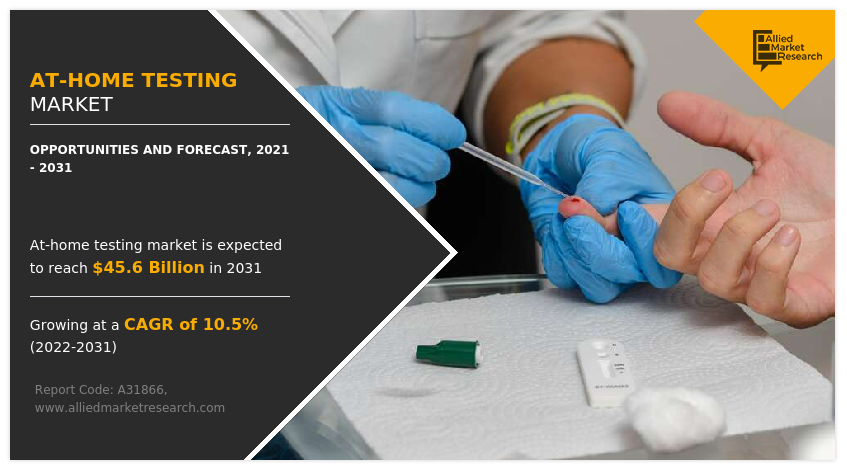
Historical overview
The market was analyzed qualitatively and quantitatively from 2020-2021. Most of the growth during this period was derived from the Asia-Pacific owing to the rise in prevalence of chronic diseases and the increase in the adoption of at-home testing kits in disease diagnosis at home, improving health awareness, rising disposable incomes, as well as the well-established presence of domestic companies in the region.
Market dynamics
The rise in technological advancement for the development of the latest at-home testing kits and devices and the rise in the prevalence of diabetes in increases the need for rapid testing kits creating an opportunity for the at-home testing market. In addition, growth of the at-home testing market is expected to be driven by the rise in awareness about the advantages offered by home-testing devices, and an increase in the demand for HIV testing kits, diabetes kits, and various others. Furthermore, the easy availability of self-testing kits at online stores and pharmacies without any prescription boosts the market growth. Moreover, the increase in the number of R&D activities in the field of at-home testing kits or medical devices enhanced healthcare services, and significant investments by the government to improve healthcare infrastructure has become a vital tool for small and large businesses globally, due to the rise in adoption for personalized self-assessing kits for the diagnosis of HIV disease. This is attributed to further support At-Home Testing Market Growth. As demand for At-home testing is not only limited to developed countries but is also being witnessed in developing countries, such as China, Brazil, and India, which fuel the growth of the market.
Furthermore, COVID-19 pandemic increases awareness among people regarding the use of self-testing kits. The COVID-19 pandemic increases the demand and production of at-home testing kits such as glucose monitoring devices, infectious diseases test kits, and other at-home testing kits, which increases the total net revenue of firms that deal in the manufacturing and distribution of testing and diagnostic devices. Therefore, to reduce the spread of the coronavirus, people are adopting more self-help testing kits due to several restrictions in place.
Furthermore, it has turned out to be a benefit for both hospitals and patients, as well as for pharmaceutical device manufacturers as hospitals are entirely focused on COVID-19 patients, and the patients can save hefty costs of doctor visits and medicine fees by self-testing some of the body vitals. It has become highly convenient for consumers as they can quickly know their test results at their fingertips. Thus, these factors are expected to create lucrative opportunities for the market to grow in the near future, providing profitable opportunities for key players post-COVID-19.
Segmental Overview
The at-home testing market is segmented on the basis of test type, age group distribution channel, and region. By test type, the market is segmented into glucose tests, infectious diseases test kits, pregnancy test kits, cholesterol test strips, drug of abuse test kits, coagulation monitoring test kits, and others. By age group, it is bifurcated into a pediatric, adult, and geriatric. By distribution channel, the market is segmented into retail pharmacies, hospital pharmacies, and online pharmacies. Region-wise, it is analyzed across North America, Europe, Asia-Pacific, and LAMEA.
By Type
Based on test type, the market is segmented into glucose tests, infectious diseases test kits, pregnancy test kits, cholesterol test strips, drug of abuse test kits, coagulation monitoring test kits, and others. The glucose test kits segment dominated the global market in 2021 and is expected to remain dominant throughout the forecast period, owing to the rise in the prevalence of diabetes which increases the demand for home-based glucose test kits that boost the growth of the At-Home Testing Market Forecast.
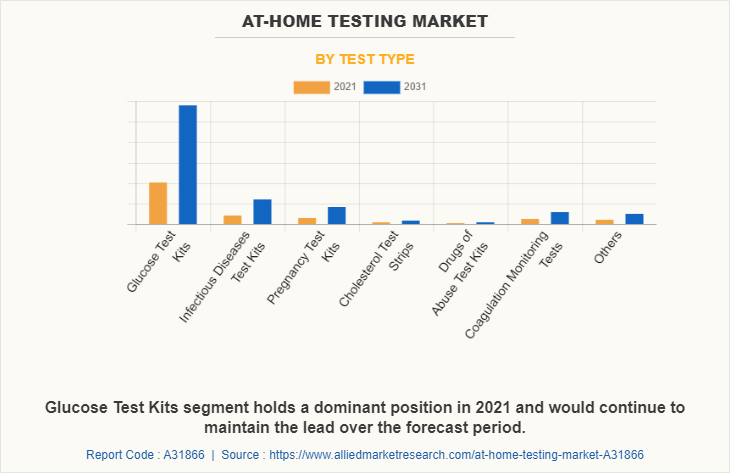
By Age Group
By age group, at-home testing market is segregated into pediatric, adult, and geriatric. The adult segment dominated the global market in 2021 and is anticipated to continue this trend during the forecast period. This is attributed to the fact that with the increase in the age of a person, the chances of acquiring cancer and chronic diseases increase, which increases the demand for diagnostic kits or medical devices by adult age group patients hence propelling the At-Home Testing Market Size.
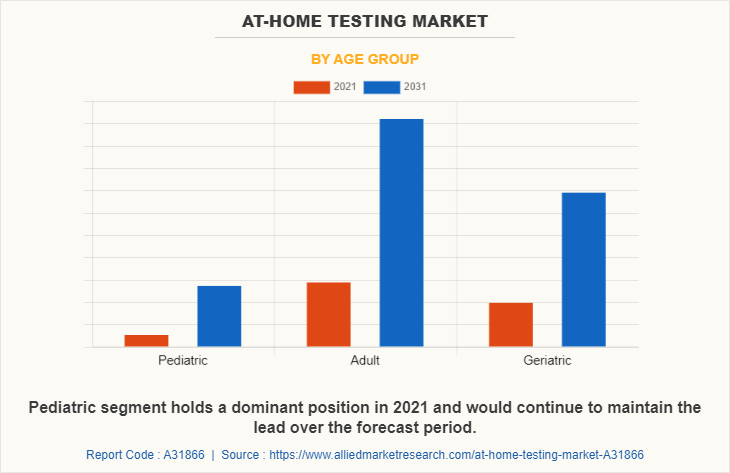
By Distribution Channel
By distribution channel, the at-home testing market is segregated into retail pharmacies, hospital pharmacies, and online pharmacies. The retail pharmacies segment has the largest At-Home Testing Market Share in 2021 and is anticipated to continue this trend during the forecast period. This is attributed to increasing investment in retail pharmacies and a shift towards more organized markets, and increased awareness of wellness and health, which increases the demand for at-home testing kits are the key factors that drive the growth of the market in upcoming years.
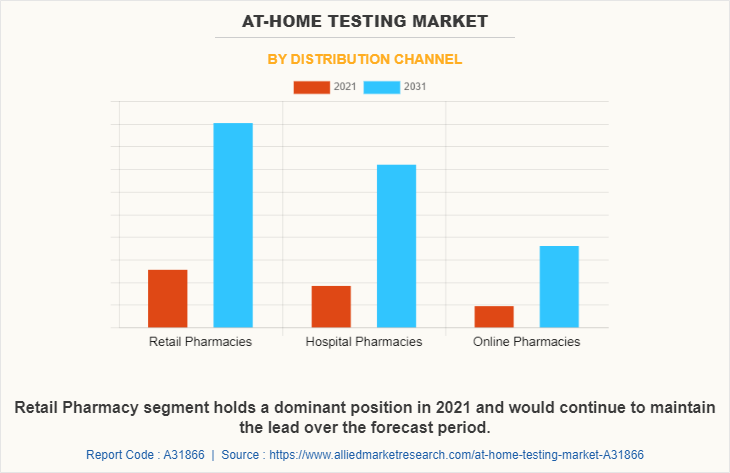
By Region
By region, the at-home testing market is analyzed across North America, Europe, Asia-Pacific, and LAMEA. North America accounted for a major share of the at-home testing market in 2021 and is expected to maintain its dominance during the forecast period. The presence of several major players, such as ACON Laboratories Inc, Cardinal Health Inc, Biomerieux SA, Abbott Laboratories, F. Hoffmann-La-Roche Ltd, B. Braun Melsungen AG, and the advancement in technology of at-home testing devices in the region drive the growth of the market. In addition, the surge in the adoption of self-testing kits owing to the pandemic, the rise in awareness about the importance of HIV diagnosis, increase in the prevalence of diabetes in the region, are the key factor that drives the growth of the market. Furthermore, product launches, mergers, collaborations, and acquisitions adopted by the key players in this region boost the growth of the market
Asia-Pacific is expected to grow at the highest rate during the forecast period. The At-Home Testing Industry growth in this region is attributable to the presence of pharmaceutical companies in the region as well as the rise in the geriatric population of the countries, such as China and India. Moreover, the rise in demand for self-testing kits owing to an increase in awareness amongst people, and advances in the medical device sector, drive the growth of the market. Furthermore, the Asia-Pacific region exhibits the largest medicine supply and the largest pharmaceutical industry with the availability of technologically advanced medical devices in abundance, which can be easily accessed by consumers. This, in turn, drives the growth of the market. Asia-Pacific offers profitable opportunities for key players operating in the at-home testing market, thereby registering the fastest growth rate during the forecast period, owing to the growing infrastructure of industries, rising disposable incomes, as well as the well-established presence of domestic companies in the region. In addition, increased technological innovations and heavy funding by government and private organizations, and increased investment by companies in R&D activities are expected to provide great opportunities for the growth of the market in this region.
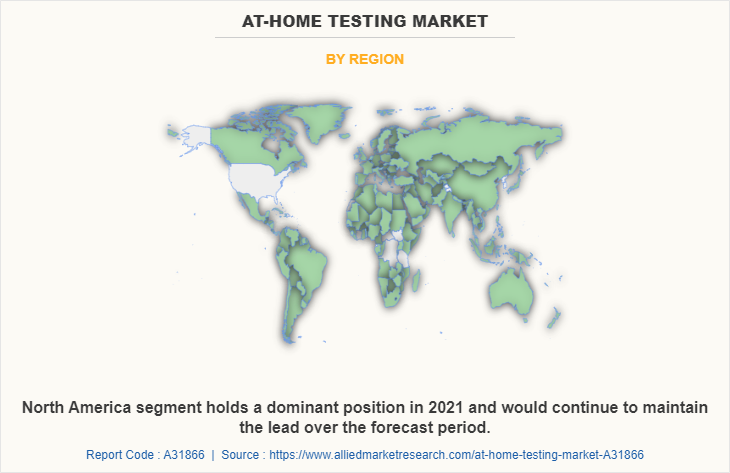
Competition Analysis
Competitive analysis and profiles of the major players in the Self-Testing Market, such as ACON Laboratories Inc, Quidel Corporation, OraSure Technologies Inc, Cardinal Health Inc, PHC Holdings Corporation, Biomerieux SA, Abbott Laboratories, F. Hoffmann-La-Roche Ltd, B. Braun Melsungen AG, and Everly Health Inc are provided in this report. Major players have adopted product launch, product expansion, and acquisition as key developmental strategies to improve the product portfolio of the At-home testing market.
Some examples of product launches in the market
Product launch in the market
- In July 2021, Abbott launched a COVID-19 home test kit in India for the detection of the SARS-CoV-2 virus in adults and children with or without symptoms.
- In June 2022, Genes2Me Pvt. Ltd., one of the leading IVD solution manufacturer in India, launched CoviEasy self-test rapid antigen test kit for COVID-19 that is easy to use and give faster results in 10 minutes. Backed by an AI-driven mobile app, this IVD product delivers a high level of sensitivity and concordance of more than 98% accuracy.
- In November 2022 Israel-based start-up invented a novel pregnancy test kit, SalistickTM which is the first rapid saliva-based pregnancy test with a new and improved user experience and high accuracy for early pregnancy detection. The kit is based on revolutionary technology which detects the pregnancy hormone β-hCG in saliva.
Key Benefits For Stakeholders
- This report provides a quantitative analysis of the market segments, current trends, estimations, and dynamics of the at-home testing market analysis from 2021 to 2031 to identify the prevailing at-home testing market opportunities.
- The market research is offered along with information related to key drivers, restraints, and opportunities.
- Porter's five forces analysis highlights the potency of buyers and suppliers to enable stakeholders make profit-oriented business decisions and strengthen their supplier-buyer network.
- In-depth analysis of the at-home testing market segmentation assists to determine the prevailing market opportunities.
- Major countries in each region are mapped according to their revenue contribution to the global market.
- Market player positioning facilitates benchmarking and provides a clear understanding of the present position of the market players.
- The report includes the analysis of the regional as well as global at-home testing market trends, key players, market segments, application areas, and market growth strategies.
At-Home Testing Market Report Highlights
| Aspects | Details |
| Market Size By 2031 | USD 45.6 billion |
| Growth Rate | CAGR of 10.5% |
| Forecast period | 2021 - 2031 |
| Report Pages | 238 |
| By Test Type |
|
| By Age Group |
|
| By Distribution Channel |
|
| By Region |
|
| Key Market Players | B. Braun Melsungen AG, Cardinal Health Inc., Everly Health, Inc, Biomerieux SA, Abbott Laboratories, F. Hoffmann-La Roche Ltd., OraSure Technologies, Inc, ACON Laboratories, Inc, PHC Holdings Corporation, Quidel Corporation |
Analyst Review
This section provides various opinions of top-level CXOs in the at-home testing market. According to several interviews conducted, the at-home testing market is expected to witness significant growth in the future, owing to an increase in the number of communicable diseases, a surge in the adoption of home testing kits or self-testing kits, and a rise in the number of geriatric populations.
According to the perspectives of CXOs, the at-home testing market is expected to witness steady growth in the future. The easy availability of home testing kits at pharmacies and the rise in the prevalence of COVID-19 cases increase the demand for self-help testing kits, which are anticipated to fuel market growth. The surge in investments in R&D by pharmaceutical companies, the growth in healthcare expenditure, and the rise in technological advancement are the key factors driving the growth of the market.
However, the high chance of inaccurate results due to self-testing hampers the growth of the market to some extent over the forecast period. As per CXOs, North America is expected to dominate the at-home testing market during the forecast period, followed by Europe. In addition, emerging economies such as India, China, Mexico, and Brazil are expected to offer lucrative opportunities owing to the introduction of technologically advanced medical devices and a rise in the demand for at-home testing kits due to an increase in the risk of a pandemic.
The forecast period in the report is from 2022 to 2031
The Upcoming Trends are rising awareness regarding the use of at-home testing products/devices, and the easy availability of testing devices at pharmacies even without a prescription. Moreover, the increase in the geriatric population and rise in the adoption of technologically advanced at-home testing devices such as pregnancy kit, HIV test kit, diabetes, and others propels the growth of the market.
$45,582.24 million is the estimated industry size of At-Home Testing in 2031
ACON Laboratories Inc, Quidel Corporation, OraSure Technologies Inc, Cardinal Health Inc, PHC Holdings Corporation, Biomerieux SA, Abbott Laboratories, F. Hoffmann-La-Roche Ltd, B. Braun Melsungen AG, and Everly Health Inc are the top companies to hold the market share in At-Home Testing
North America is the largest regional market for At-Home Testing
The base year for the report is 2021
Yes, AT-Home Testing market companies are profiled in the report
No, there is value chain analysis provided in the AT-Home Testing market report
Loading Table Of Content...



